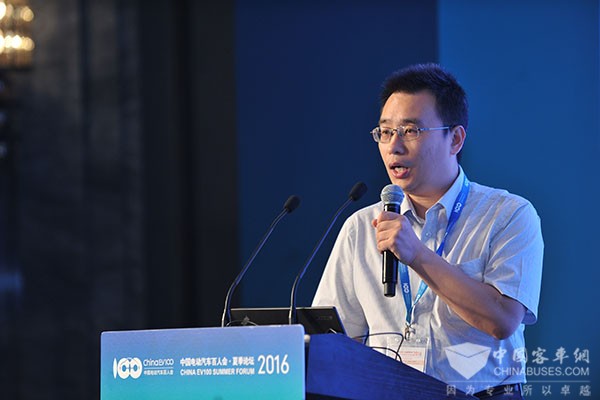Themed with “Safety and Innovation”, China EV100 2016 Summer Forum was held in Zhengzhou on August 21. Participants from Chinese Academy of Engineering, various auto makers, related enterprises and government organizations were gathered to brainstorm the solutions for the safety concerns and technological bottlenecks faced by electric vehicle industry.
At the Summit themed with “Technological Progress and Auto Safety” held in the afternoon, Dr. Li Feiqiang, Deputy Director of China National Electric Bus Electric Control and Safety Engineering & Research Center, was invited to deliver a keynote speech. Hereafter is Dr. Li’s speech.

Dr. Li Feiqiang delivered a speech
A.The Current Development Status of China’s Electric Bus Industry
As of the end of 2015, the number of electric buses in operation in China had reached 166,712 units, accounting for 13.18% of all buses in service. The number of electric city buses reached 118,109 units, making up 27% of the city bus fleet in China. After five year’s operation in large numbers, electric buses have become increasingly popular among bus operators thanks to their improved reliability and marked superiority in energy conservation and emission reduction. Moreover, their operation has helped the industry realize an increase in value by 600 billion RMB.
Yutong, as the bellwether in China’s bus industry, developed its first electric bus in 1999. In 2005, it rolled out its first hybrid bus. In 2014, it set up China’s Electric Bus Electric Control & Safety Engineering Research Center. In 2015, Yutong’s Energy-saving and New Energy Bus Industrialization Project was the only one that won China’s National Technological Progress Award. In the same year, it realized a sales volume of over 67,000 units and a sales revenue of 31.2 billion RMB. As of June 2016, the number of Yutong energy-saving and new energy buses in operation had reached over 42,000 units, accounting for 23.7% of the overall electric bus market in China. In 2015 alone, Yutong sold over 21,000 units electric buses. Now, Yutong electric buses can be found in 261 cities across China.
B. The Technological Advances of Electric Buses
China’s bus makers has long become less dependent on their foreign counterparts for key bus manufacturing technologies. Moreover, electric buses made in China have been constantly improving their performance in terms of energy consumption and continuous driving distance. The energy density of power batteries and the efficiency of power motors have also been making great progress. In addition, China is able to produce sample fuel-cell buses and it has achieved great success in intelligence driving technologies.
China’s plug-in hybrid buses have already reached the highest energy efficiency in the international market by independently developing whole vehicle control system, integrated electric driving system and energy-saving electric system. China is now able to independently develop and produce batteries, electric motors and electric controls for electric buses, making electric buses more reliable and more competitive.
In fuel cell buses, China still lags far behind in the international market in terms of battery life expectancy, production costs and adaptability. In August, 2015, Yutong successfully finished China’s first large-sized bus intelligence driving test. Yutong’s intelligence driving control system integrating radar, visual technologies, communication technologies and navigation technologies helps vehicles realize auto driving, auto charging, intelligence dispatching, intelligence maintenance, etc.
C. Safety Standard Improvement of Electric Buses
China National Electric Bus Electric Control and Safety Engineering & Research Center is chiefly involved in researching and developing electric control technologies and ensuring the highest safety standards for all electric vehicles. The center now carries in work in six major areas, namely battery safety, water resistance, fire prevention, protection against electric shock, monitoring and collision.
D. Problems and Suggestions
It is to be congratulated that China has successfully completed the first phase of its development in new energy vehicle industry. To realize the goal in the second phase by 2020, the country is still facing a host of challenges. More efforts must be made in researching and developing fuel cell technologies. In addition, the market must further liberalized to encourage fair competition and enhance China’s overall competitiveness in the global electric bus market.
As opportunities always go hand in hand with challenges. China’s bus makers should make all their efforts in improving the safety standards and quality standards of their future electric buses. Only in doing so can electric buses realize higher market presence, making their share of contributions to China’s drive for energy conservation and emission reduction.